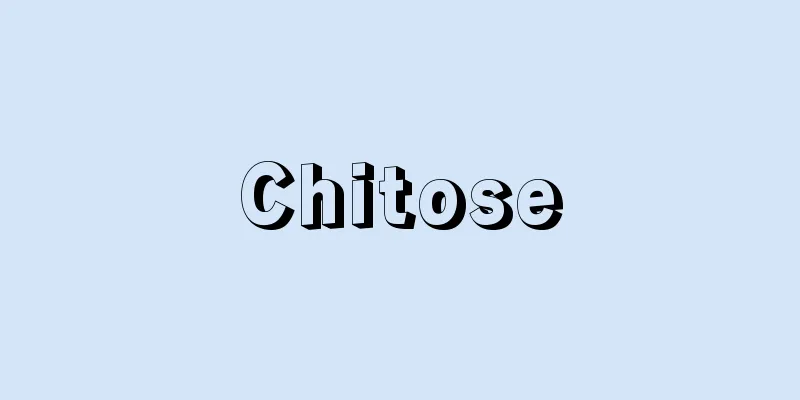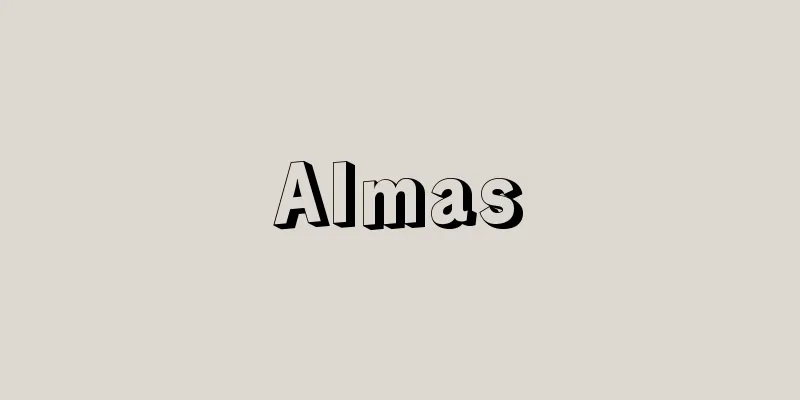Middle class - chukanso (English spelling) middle class

|
In the class and hierarchical structure of society, the middle class refers to a miscellaneous group of people who do not belong to either the upper or lower classes, but form an intermediate group. Therefore, even if it is simply called the middle class, its characteristics are extremely unclear, and it is diverse in terms of occupation, income, educational background, etc., and it lacks the ability to act and collective unity. It is also considered to be always fluctuating between the upper and lower classes, lacking a solid foundation, and occupying an intermediate and floating position politically, economically, and socially, and to perform an intermediate and intermediary function accordingly. [Akira Hamashima] The old and new middle classesAlthough it is composed of various elements, if we were to group them, they could be divided into the old middle class (also called the middle class), which is made up of self-employed farmers, manufacturers, and merchants based on traditional occupations, and self-employed professionals, and the new middle class, which is made up of employed workers engaged in clerical, service, and sales-related work that have appeared in large numbers as the industrial structure has changed. The former is distinguished from the lifestyle of employed workers who do not own the means of production, but make a living by selling their labor as a commodity, due to the characteristics of their lifestyle derived from the ownership of means of production or business and other assets. In addition, the concept of the middle class, which mediates between the ruling class and the dominated class, is sometimes used as a functional concept in political science. In this case, it is considered to be a group of people who are at the bottom of the pyramidal power structure in society, identify with power, and either exercise power over the dominated class or play the role of mediating power. In political science, first-line supervisors in a company, non-commissioned officers in the military, important families in a village, political bosses, etc., are intermediate between the ruling class and the dominated class, and mediate power, fulfilling the important function of channeling conformity to the system. By the way, the "middle" in the middle class means the part that has not been differentiated or decomposed into either the upper or lower extremes. This middleness focuses on the situation where society is not completely decomposed into two extremes, capitalists who own the means of production and exploit the labor of others, and workers who do not own them and are exploited by others, but an intermediate layer remains that owns the means of production but does not exploit the labor of others (or exploits them to a lesser extent). Opinions are divided as to whether these intermediate owners tend to decompose into either extreme sooner or later. In addition, when looking at material wealth, standard of living, lifestyle, and attitude toward life, this middleness applies to the many people who are neither rich nor poor when distinguished into rich and poor, upper and lower classes, etc., and these people are lumped together as the middle class or middle class. When we talk about the middle class, we mean people whose level of wealth or standard of living is in the middle. However, it is not necessarily clear by what standards this middleness is measured. [Akira Hamashima] Class theory and the middle class problem(1) Historically, the Third Estate (free traders and merchants) that rose in the autonomous cities at the end of the Middle Ages constituted an intermediate class between the privileged ruling class and the unprivileged common people, and became the driving force of the civil revolution. However, after the establishment of capitalism, the petit bourgeoisie (self-employed farmers, craftsmen, and merchants) between the bourgeoisie and the proletariat were positioned as the middle class. People involved in these traditional modes of production are called the old middle class. In contrast, when capitalism became highly developed, a huge group of employed workers appeared who were involved in non-operational departments such as professional, administrative, clerical, and sales work, due to changes in the industrial structure and the large-scale and complexification of industrial organizations. They worked as management assistants between capitalists/managers and workers, or worked in interpersonal relationships using symbols in offices rather than at the production site. This group of people is called the new middle class to distinguish it from the old middle class, and is also called white-collar workers in contrast to blue-collar workers. (2) As capitalism becomes more advanced, the old middle class has declined or stagnated, and in its place has been a rapidly growing class of the new middle class, with an extremely diverse range of occupations. This historical trend has raised important questions for Marxist class theory. In Marxism, capitalist society is made up of two major classes, the labor and capital classes, and the rest are, so to speak, intermediate and transitional, with no subjective power to shape and advance history, and it is believed that as capitalism develops, this intermediate class will polarize into the two major classes, the labor and capital classes. It is true that this polarization process has been completed for the peasant class, but the self-employed merchants and industrialists do not necessarily show a linear trend of decline, and in fact there is a slight tendency for them to increase. Moreover, compared to the stagnation of the old middle class, the fact that the new middle class has grown rapidly since the end of the 19th century, especially during the process of social change after World War II (the advancement of industry, the bureaucratization of organizations, etc.) has meant that classical poverty has disappeared due to the improvement in living standards accompanying the dramatic rise in productivity, and the standardization of lifestyles, resulting in the arrival of a "leveled middle-class society" in which impoverishment appears to have been eliminated, provides strong evidence for denying the existence of a unique proletarian tendency. [Akira Hamashima] Deproletarianization and middle-class consciousnessHow we view the growth of the new middle class is deeply related to the question of how we understand the form of existence and the direction of development of the class structure of modern industrial society, and it can be said that the problem of the middle class lies there. The generalization of the petty bourgeois lifestyle and way of thinking represented by the new middle class has had the effect of deproletarianizing people, who are buried in the system in an attempt to make their private lives more comfortable, and have dulled class struggle and class consciousness, forming the background to the situation in which so-called middle-class consciousness is spreading among a wide range of classes, including the working class and the bottom class. In that respect, it is not impossible to say that modern society is a society in which a large number of people (middle mass) who are widespread and diverse, but fairly homogeneous in their lives and consciousness, are concentrated in the middle part of the class structure. [Akira Hamashima] "White Collar" by Mills, translated by Sugi Masataka (1957, Sogensha) " ▽ "The Japanese Middle Class" by Okochi Kazuo (1960, Bungeishunju Shinsha) ▽ "The Fake Middle Class" by Ishikawa Akihiro et al. (1982, Yuhikaku) ▽ "The Illusion of the 'Middle Class'" by Kishimoto Shigechin (Kodansha Bunko) [Reference] | |Source: Shogakukan Encyclopedia Nipponica About Encyclopedia Nipponica Information | Legend |
|
社会の階級・階層構造において、その上下いずれの層にも属さず、中間的な部分を構成する雑多な諸階層をさす。したがって、ひと口に中間層といってもその性格はきわめて不明確であり、職業、収入、学歴などの点でも多種多様であって、それ自体行動能力をもたず集団的まとまりを欠く。それはまた、上層部分と下層部分との間にあってつねに動揺し、確固とした基盤をもたず、政治的にも経済的にも社会的にも中間的・浮動的な立場にたち、それに応じた中間的・媒介的な機能を営む、と考えられている。 [濱嶋 朗] 旧中間層と新中間層雑多な要素から構成されるが、しいてグルーピングをすれば、伝統的な生業基盤にたつ農・工・商業自営層および自営の専門的職業者からなる旧中間層(中産階級ともよばれる)と、産業構造の変化につれて大量に出現した事務・サービス・販売関係業務に従事する雇用勤労者、つまり新中間層とに分けられる。前者は生産手段または営業手段その他の資産所有に由来する生活様式の特性によって、生産手段を所有せず自己の労働力を商品として売ることによって生計をたてる雇用労働者の生活様式とは区別される。 なお、政治学上の機能的概念として、支配層と被支配層を媒介する中間層概念が用いられることがある。この場合、社会のピラミッド型権力機構の末端に位置し、権力に同一化し、被支配層に対し権力を行使するか権力を媒介する役割を果たす一群の人々が考えられている。政治学的には、企業内の第一線監督者、軍隊の下士官、村の重立(おもだち)(旧家)層、政治ボスなどは、支配層と被支配層との中間にあって権力を媒介し、体制順応に水路づける重要な機能を果たしている。 ところで、中間層という場合の「中間」は、上下いずれかの両極に対して、この両極に分化・分解していない部分を意味している。この中間性は、生産手段の所有に関しては、それを所有して他人労働を搾取する資本家と、それを所有しないために他人によって搾取される労働者に社会が完全に両極分解し尽くすのではなく、その中間形態として生産手段を所有するが他人労働を搾取しない(もしくは搾取してもその度が少ない)層が残留する事態に着目する。この中間的所有者が早晩いずれかの極に分解する傾向にあるとみるかみないかについては意見は分かれるが。また、この中間性は、物質的な豊かさや生活程度あるいは生活様式、生活態度についてみると、金持ちと貧乏人、上層と下層などに区別された場合に、金持ちでも貧乏人でもない多数の人々に当てはまり、これを中間層ないし中流階級として一括することになる。中流階級というときには、豊かさの程度または生活程度が中位の人々を意味する。しかし、この中間性がいかなる基準によってどのように測定されるかは、かならずしも明確ではない。 [濱嶋 朗] 階級理論と中間層問題(1)歴史的には、中世末期の自治都市に興隆してきた第三身分(商工自由業者)が、特権的支配身分と特権のない一般庶民との間の中間層を構成し、市民革命の推進勢力となったが、資本主義確立後はブルジョアジーとプロレタリアートの間に挟まれた小市民層(プチ・ブルジョアジー)(農・工・商業自営層)が中間階級として位置づけられた。これらの伝統的生産様式に携わる人々を旧中間層とよぶ。これに対し、資本主義が高度に発達した段階で、産業構造の変化や産業組織の大規模化・複雑化などに伴い専門・管理・事務・販売などの非現業部門の業務に携わる膨大な雇用労働者群が登場し、資本家・経営者と労働者との中間にあって経営補助労働を行うか、生産現場ではなく事務所でシンボルを用い対人関係において働くようになった。この一群の人々を旧中間層と区別するために新中間層とよんでいるが、これはブルーカラーに対してホワイトカラーともよばれている。 (2)資本主義の高度化につれて旧中間層は没落ないしは停滞傾向をたどり、これにかわって新中間層というきわめて雑多な職業につく階層が急速に増大しつつあるが、この歴史的趨勢(すうせい)はマルクス主義の階級理論にとって重大な問題提起をする結果になった。マルクス主義においては、資本主義社会を構成するのは労資二大階級であり、ほかはいわば中間的・過渡的存在であって、歴史を形成し推進する主体的力量もなく、資本主義の発展につれこの中間部分は労資二大階級に両極分解を遂げるものとされていた。確かに、農民層については両極分解過程は遂行されたが、商工業自営層についてはかならずしも直線的な没落傾向はみられず、むしろ微増する傾向もないではない。そればかりか、旧中間層の停滞傾向に引き比べ、19世紀末以来、とくに第二次世界大戦後の社会変動(産業の高度化、機構の官僚制化など)の過程で新中間層が急激に肥大化した事実は、生産力の飛躍的上昇に伴う生活水準の向上、生活様式の標準化などにより古典的な貧困が姿を消し、窮乏化を解消したかにみえる「平準化された中間階級社会」の到来と相まって、一義的なプロレタリア傾向を否定する有力な根拠となった。 [濱嶋 朗] 脱プロレタリア化と中流意識新中間層の肥大化をどうみるかは、現代産業社会の階級構造の存在形態と発展方向をどうとらえるかという問題に深くかかわっており、そこに中間層問題の問題性があるといってよい。新中間層に代表される小市民的な生活様式と思考様式の一般化は、私生活の快適化を図るあまり体制内に埋没し、階級闘争や階級意識を鈍らせる脱プロレタリア化の作用を及ぼしており、いわゆる中流意識が労働者層や底辺層を含む広範な階層にはびこりつつある事態の背景をなしている。その点で、現代社会は、階級構造の中間部分に広範かつ多様な、しかしその生活と意識においてかなりに同質的な大量の人々(ミドル・マスmiddle mass)が集中する社会である、といえないこともない。 [濱嶋 朗] 『ミルズ著、杉政孝訳『ホワイト・カラー』(1957・創元社)』▽『大河内一男著『日本的中産階級』(1960・文芸春秋新社)』▽『石川晃弘他著『みせかけの中流階級』(1982・有斐閣)』▽『岸本重陳著『「中流」の幻想』(講談社文庫)』 [参照項目] | |出典 小学館 日本大百科全書(ニッポニカ)日本大百科全書(ニッポニカ)について 情報 | 凡例 |
<<: Intermediate Value Theorem
>>: Criticism of the Intermediate Person Theory
Recommend
Person's name - jinmei
An individual's given name. In Japan, a person...
Kakiami (English spelling) lead net
A net that forms part of a fixed fishing net. It ...
Ishikari Bay
A bay facing the Sea of Japan in central-wester...
Mirror of House Patterns - Kaokumonkyo
This is a 4th century imitation mirror with a hou...
Ochna multiflora (English spelling)
… [Mitsuru Hotta]... *Some of the terminology tha...
Dollar shortage - dollar shortage
The four to five years immediately following World...
Sæverud, H. (English spelling) SaeverudH
…Stavkirke (staved churches), a style of church a...
Polyandry - Issaiitafusei
...The type of pair relationship that is formed b...
Juglans; walnut
It is a general term for the genus Juglans in the ...
Ukufu - Ukufu
...Pilgrims, clad in two seamless white cloths (i...
Convex function
Within the interval in which the function y = f ( ...
National Assembly (English: Assemblée nationale) (French)
The term is usually used to refer to the first Fr...
Mantoux, C. (English spelling) MantouxC
…Tuberculin was created in 1890 by R. Koch, the d...
"Gyozanshuryakubon" - Gyosanshuryakubon
...This Soen edition became the prototype for the...
Paul Berg
American molecular biologist. Born in New York. H...









